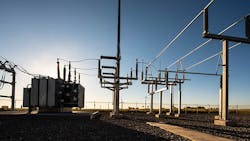ARIES Microgrid Infrastructure Powers NREL Campus Through Outage
Less than two months after the Department of Energy and the National Renewable Energy Laboratory (NREL) commissioned utility-scale infrastructure for the Advanced Research on Integrated Energy Systems (ARIES) research platform, it experienced a utility-scale emergency: An outage at NREL's Flatirons Campus cut power to the entire site, including its servers, offices, and research hardware.
With resilience and recovery as its cornerstones, ARIES suddenly graduated from concept to critical application and was used to repower the Flatirons Campus exactly as envisioned for renewable microgrid systems of the future.
ARIES' trial by fire began when a voltage-monitoring potential transformer exploded—a mechanical failure that is familiar to utilities. The Flatirons Campus is normally tied to local Xcel Energy lines, but the failure disabled the campus's substation infrastructure that interfaces with Xcel. Observing the damage, NREL's response team expected weeks of lost research waiting for a new transformer to be acquired and installed. But then the team looked out at the 300-acre campus.
"At Flatirons, we are surrounded by renewable assets; assets that we have spent a lot of time characterizing and validating," said Robb Wallen, lead engineer of grid integration research at the Flatirons Campus. The NREL response team—a mix of environmental health and safety professionals, research engineers, center directors, technicians, Department of Energy support, and site operations groups—realized that with ARIES capabilities, the Flatirons Campus had everything it needed to make a microgrid.
"We wanted to restore the campus for our research, which drove a sense of urgency," Wallen said. "We have shown the capability in a research environment, and we've always talked about islanding, but no one has asked us to do it." While this outage was also not asked for, NREL had the expertise in microgrids and black starts to act quickly. Within a week, the outage transformed into a live experiment—the first ARIES case study.
"A big part of the ARIES story is that our future renewables-centric grid will be able to operate safely and reliably, providing power when it is needed," said National Wind Technology Center Director Daniel Laird, who first suggested powering the site with ARIES assets until the substation could be repaired. "Here was a real-world opportunity to show it."
The recovery proceeded like a page out of an NREL technical report. Researchers started with the servers—the brains of the infrastructure. Using NREL's 1-MW research battery, which was at 80% charge following the outage, the team was able to first repower the control room. With the control room online, the team could begin the black start.
"From a research point of view, it was interesting. We started locally, then closed in the circuit breakers," Wallen said. "The process was: black start the battery, then connect the solar—which we had characterized before connecting with the battery." Wallen and team wrote up their procedure, which was then vetted by NREL's response team. Following some final validations, the plan was approved and began providing renewable power to the campus's 200-kW load in place of a functional grid-tied substation.
The researchers succeeded in connecting a 430-kW PV solar array, and a 1.5-MW wind turbine, which charged the battery that served the campus. This microgrid demonstrated a unique control methodology called AC coupled that eliminates the need for communication links between all of the technologies, ensuring a very resilient microgrid configuration. Altogether, the microgrid validated a core principle of ARIES: Renewables can enhance resilience and flexibility across power systems large and small. Engineers could hardly ask for—and assuredly did not ask for—a higher-fidelity proof.
"Our team has taken this event and accelerated the development of a critical capability in the ARIES research platform," Center Director of Energy Conversion and Storage Systems Jennifer Kurtz said. "Having this research capability enables us to study different microgrid configurations that can address all three ARIES challenges of variety in scale, secure control of interconnected devices, and integration of diverse technologies."Besides demonstrating ARIES concepts such as black start dynamics and utility microgrid controls, the outage also showcased NREL's operational collaboration in promptly repowering the campus.
"This emergency showcased the ingenuity and flexibility of our NREL engineers, scientists, and staff," Laboratory Director Martin Keller said. "Our researchers worked together to make lemonade out of lemons. Their creativity in seizing these adverse circumstances as an opportunity to scientifically demonstrate the capabilities of our cutting-edge ARIES technologies was outstanding."
The coordination among safety, technical, and leadership teams offers a case study all its own, with at least as much importance to a successful islanding.
"The key was understanding all of the safety implications of doing something we had never done before," Laird said.
The microgrid repowered the Flatirons Campus just in time to complete end-of-fiscal-year research and reporting. With the new transformer installed, and following a safe reconnection with Xcel, NREL looks forward to exploring future grid integration pathways with ARIES capabilities.
